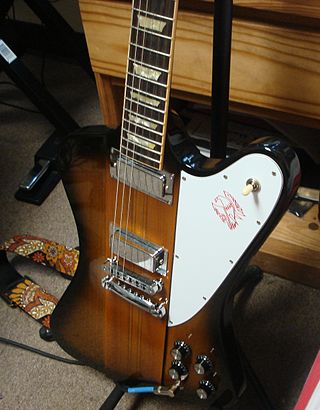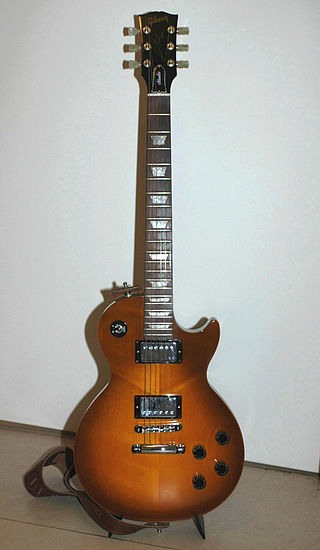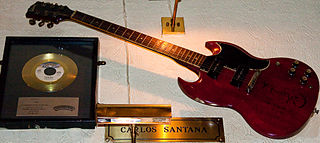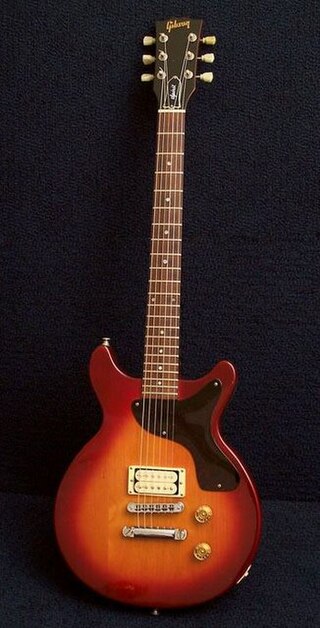
The Gibson SG is a solid-body electric guitar model introduced by Gibson in 1961, following on from the 1952 Gibson Les Paul. It remains in production today in many variations of the initial design. The SG Standard is Gibson's best-selling model of all time. SG stands for "solid guitar".

The Gibson Les Paul is a solid body electric guitar that was first sold by the Gibson Guitar Corporation in 1952. The guitar was designed by factory manager John Huis and his team with input from and endorsement by guitarist Les Paul. Its typical design features a solid mahogany body with a carved maple top and a single cutaway, a mahogany set-in neck with a rosewood fretboard, two pickups with independent volume and tone controls, and a stoptail bridge, although variants exist.

The Fender Jazzmaster is an electric guitar designed as a more expensive sibling of the Fender Stratocaster. First introduced at the 1958 NAMM Convention, it was initially marketed to jazz guitarists, but found favor among surf rock guitarists in the early 1960s. Its appearance is similar to the Fender Jaguar, though it is tonally and physically different in many technical ways, including pickup design, scale length and controls.

The Gibson Firebird is a solid-body electric guitar manufactured by Gibson beginning in 1963.

The Gibson Explorer is a type of electric guitar model by Gibson guitars, released in 1958. The Explorer offered a radical, "futuristic" body design, much like its siblings: the Flying V, which was released the same year, and the Moderne, which was designed in 1957 but not released until 1982. The Explorer was the final development of a prototype design that, years later, Gibson marketed under the name Futura.

The G-400 is an Epiphone solid body electric guitar model produced as a more modestly priced version of the famous Gibson SG. Currently, Epiphone is a subsidiary of Gibson and manufactures the G-400 and other budget models at a lower cost in Asia. Visually and ergonomically, it is almost identical to a 1962 SG.
The Gibson EB-0 is a bass guitar that was introduced by Gibson in 1959. When production ceased in 1979, a total of 20,844 instruments had been built.

The Gibson Les Paul Doublecut is a double-cutaway version of the Gibson Les Paul electric guitar.
The Gibson Les Paul Junior is a solid-body electric guitar introduced in 1954 as an affordable, entry-level Les Paul. It was first released with a single-cutaway body style; models with a double-cutaway body style were introduced in 1958. The Junior continued through the first three years of the Les Paul/SG body redesign. The initial run was discontinued in 1963.
The Gibson Melody Maker is an electric guitar made by Gibson Guitar Corporation. It has had many body shape variations since its conception in 1959.

The Gibson Les Paul Studio is a solid body electric guitar produced by the Gibson Guitar Corporation since 1983. It is a model of Les Paul with some features omitted to appeal to musicians looking for the tonal qualities of the guitar but with less of an emphasis on cosmetics and to reduce the price of the instrument.

The Gibson L6-S is a solid body electric guitar. It was the descendant of the L5S jazz solid-body electric guitar. It was the same shape, very much like a wide Gibson Les Paul, but with a 24-fret neck, the first Gibson guitar to have this.
The Gibson Les Paul bass is a bass guitar first manufactured by Gibson in 1969, just after the relaunch of the Les Paul guitar in 1968.
The Gibson Les Paul Custom is a higher-end variation of the Gibson Les Paul guitar. It was developed in 1953 after Gibson had introduced the Les Paul model in 1952.

The Gibson SG Special is an electric guitar made by Gibson that has been manufactured since 1961.

The Gibson Spirit was a guitar model sold under Gibson and Epiphone USA nameplates in the 1980s. This article does not refer to the made-in-China Spirit guitar sold under the Gibson Baldwin Music Education nameplate.

The Paul is an electric guitar made by Gibson, manufactured from 1978 to the 1980s.

The Gibson Les Paul Special is a variation of the Gibson Les Paul guitar. It was introduced in 1955. It is designed to be an intermediate level instrument, at a price point and trim level between the low-cost Les Paul Junior and the standard Les Paul.

The Gibson ES-165 Herb Ellis is an Archtop guitar manufactured by the Gibson Guitar Corporation in Nashville Tennessee. By March 2013, it was no longer in production.
The Fender Telecaster, colloquially known as the Tele, is an electric guitar produced by Fender. Together with its sister model the Esquire, it was the world's first mass-produced, commercially successful solid-body electric guitar. Its simple yet effective design and revolutionary sound broke ground and set trends in electric guitar manufacturing and popular music. Many prominent rock musicians have been associated with the Telecaster for use in studio recording and live performances, most notably Bruce Springsteen, Luis Alberto Spinetta, Keith Richards and George Harrison.














